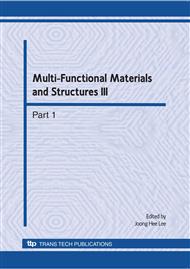p.226
p.231
p.235
p.239
p.243
p.247
p.251
p.256
p.260
Study on the Mechanical and Electrical Properties and Creep Behaviour of Carbon Fiber Nano-Composites
Abstract:
In recent years, the influence of surface modification of carbon nanotubes (CNTs ) on CNT’s dispersion among epoxy resin, mechanical properties and electrical conductivities of CNTs has been observed. On account of above-mentioned effects, that CNTs treated with oxidizing in organic acids, a kind of surface modification, generates functional groups on the surface of CNTs is a major investigation in this study to enhance mechanical properties and electrical conductivities of CNTs. In this study, CNTs dispersed among epoxy resin well by adopting ultrasonication method and then the nano-prepreg was fabricated by mixing CNTs/Epoxy resin into carbon fiber. The influence of the different proportion contents of CNTs added into Epoxy resin on mechanical properties and electrical conductivities of composites is investigated. The strength of material tested under different circumstance is also observed. Furthermore, the creep behavior of carbon fiber/epoxy resin thermosetting composites tested under different circumstance and stress is also concerned to be analyzed.
Info:
Periodical:
Pages:
243-246
Citation:
Online since:
August 2010
Authors:
Keywords:
Price:
Сopyright:
© 2010 Trans Tech Publications Ltd. All Rights Reserved
Share:
Citation:


